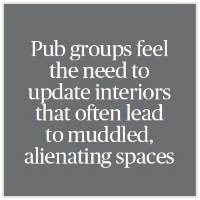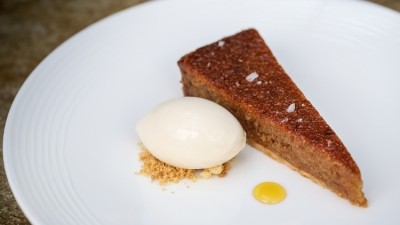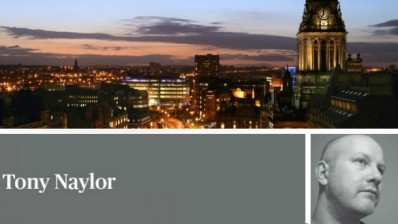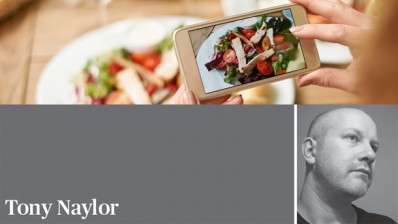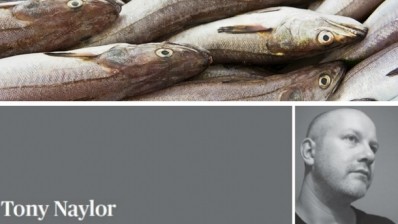MONTHLY COLUMN
Pub design? It’s no small beer
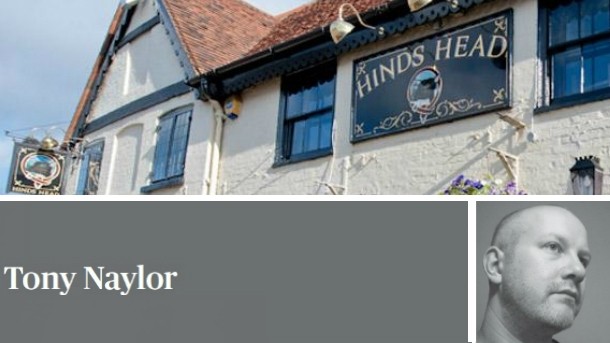
I realise, in a world that contains Donald Trump and ISIS, it may seem trivial. Ultimately, it is. But I find the news that a pub I love is about to undergo a refurb terrifying.
This month, I am holding my breath as Heston Blumenthal’s The Hinds Head goes under the drill and hacksaw. When it reopens on 20 April – with three-to-six-course set menus; glassed-in restaurant wine wall; and new ‘opulent’ cocktail lounge – will it still feel like a pub?
You may argue it never did. This is a Michelin-star dining destination. Except that, certainly in its early years, the beauty of The Hinds Head lay not within the restaurant, but in its Grade II-listed oak-panelled saloon (a timeless cocoon the refurb will leave untouched; where you still cannot book).
Sat here, it was possible, as Bray locals nattered at the bar, to see The Hinds Head as a vision of the Utopian boozer. One that served exceptional food, but where eating was not obligatory and, at the next table, someone might be reading the paper over a pint.
The interior design crossroads that The Hinds Head finds itself at is one that many pubs must navigate. Few do it successfully. I am not talking here about de facto restaurants that happen to occupy old pub buildings, but about those many pubs which, even if food-led, still seek to project themselves as free-flowing, multi-purpose public houses. Perhaps by retaining plenty of drinking space or refusing to book out tables.
In that sphere, horrendous damage is frequently done to previously welcoming pubs. Brainwashed by the mantra ‘pubs are dying’, pub groups often feel the need to update interiors in ways which, while they may seem to make conceptual business sense on paper, often lead to muddled, alienating spaces.
Think of light ’n’ airy suburban pubs designed to attract mums for coffee at 11am, which are largely deserted on Friday nights. In such way pubs fritter away their mass appeal.
Fundamentally, for me, interior design in pubs is a retro project; one at its best when it is intuitively sympathetic to the building, whether it dates to 1974 or the 17th century. That need not be executed in clichéd ways with Victoriana and Punch prints (alarmingly, The Hinds Head will feature ‘eccentric curiosities’), nor does it mean your pub must look old, tatty and dingy. Pubs can be polished up, sensitively.
It is a design cliché now (my advice, in pubs: ignore fashion), but one of the most successful recent reappraisals of the pub interior was the widespread mid-noughties ‘Farrow & Ball refit’. Old beams were uncovered, mismatched furniture bought in and pubs treated in greige tones that were smart without being overbearing. It worked.
The interior design industry does not exist to sell a suitable solution once, however, hence so many pubs being ruined by unnecessary overdesign.
Restaurant copyists are a huge problem. I do not mean those pubs rocking open kitchens and centrepiece pizza ovens (although, naturally, those dissuade drinkers from lingering) but, rather, pubs that gormlessly ape vogueish hospitality industry interiors – often in a bizarre mishmash of styles: part NY diner, part sheepskin-clad hygge hideaway, part graf-tagged dude food shack.
Likewise, aspirational ale houses (all posing tables for the high-spend prosecco hordes and blingy wallpapers), or those that, patronisingly, claim to be feminising their interiors (think: tartan cushions, flowers, lime-washed furniture), frequently become sterile, niche spaces that, subsequently, struggle to maintain a broad customer base.
Pubs need a good product and a populist, even neutral feel. Radical design can be actively harmful. Instead, choose better drinks, better food and a modest, fitting facelift.
